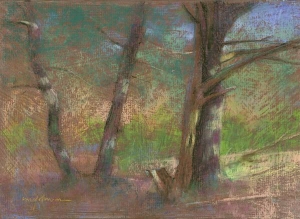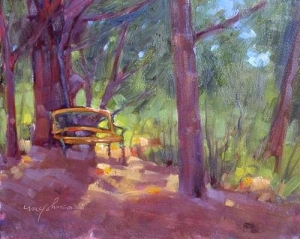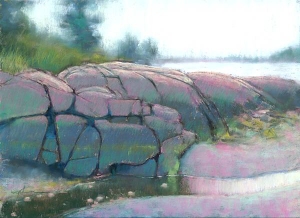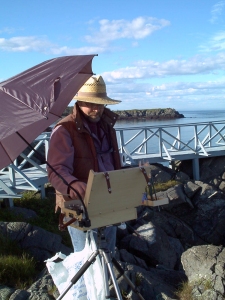| |
When
I say en plein
air to most people, I usually get a quizzical look.
But, if I say it to one of my landscape painting
friends, he grabs his paintbox and is rarin' to go.
Although this French phrase simply means "in the open
air," it is packed with meaning for landscape painters.
Painting en plein air is an old tradition that
has become a new passion among today's landscape
artists.
But before we get into the history, why paint outdoors
at all? Are we not painters more comfortable in the
studio where we have all our tools and materials close
at hand? Do we not have a better experience indoors,
where we can brew a pot of coffee, spin up Puccini on
the CD player, and paint through the night? Well,
certainly, there is a great deal to be said for painting
indoor. But the outdoor experience fires up a connection
to the real world you just do not get when in the
studio.
| |
|
 |
|
|
Companions
en plein air
By Michael Chesley Johnson
Pastel, 9" x 12" |
|
| |
|
 |
|
|
Evening Light
en plein air
By Michael Chesley Johnson
Oil on panel, 8" x 10" |
|
| |
|
When I work outdoors, I am immersed totally in God's
world – the fragrance of the pines, the sun beating down
on my broad-brimmed hat, the vibrant colors lurking in
the shadows. I like to compare that connection to
Communion. I feel the Holy Spirit working through me,
guiding my eye and hand. The joy is strangely and
wonderfully addictive.
Of course, there are challenges. First, you have a time
limit. If you plan to finish your painting in one
session – in what is called "alla prima" fashion – you
have no more than two hours in which to do so. As you
paint, the sun constantly changes its position in the
sky. Shadows lengthen or shorten, move across the
landscape. The color of sunlight changes, going from
morning's warm yellow to noon's cool greenish-yellow,
and on to evening's warm orange. The challenge is to not
"chase the sun", but to capture the moment that
originally inspired you.
The tides present a similar challenge in the Bay of
Fundy, where I paint in the summer. They can rise or
drop as much as 20 feet in 6 hours – that's over 3 feet
an hour! Rustic wharf buildings perched enticingly over
a mirror-like expanse of water are soon high-and-dry
above an expanse of seaweed and beached boats. You
really have to see it to believe it.
Another challenge is the weather. Clouds can change the
dramatic appeal of a landscape in seconds. A sudden gust
of wind can blow your easel over. Cold will numb your
fingers and cause you to drop a brush. If you paint in
oil, you can stand a certain amount of drizzle coming
down, but if you paint in pastel, the least drop will
ruin your work. And the bugs! Oil paint attracts gnats,
which become mired down in it. Then there are the
mosquitoes and blackflies ...
| |
 |
| |
Fog Rolling In,
Hamilton Beach Cove
en plein air
By Michael Chesley Johnson
Pastel, 9" x 12" |
| |
|
But these and all the other challenges are part of the
experience. Not everyone is cut out for plein air,
just as not everyone is cut out for camping. Some revel
in the pain and suffering. All of us revel in the joy.
So how did this all begin? Although artists have always
gone out to sketch, outdoor painting really took off
after 1841, when the collapsible paint tube was
invented. Prior to this, oil painters had to load their
paint into sacks made from pig's bladders – a nasty and
cumbersome process, one must assume. The paint tube made
transport of paint much easier. According to Renoir,
"Without tubes of paint, there would have been no
Impressionism." The Impressionists believed that to
truly capture the light, one had to paint outdoors.
In the last 10 years or so, outdoor painting has become
even more popular. Part of this is due to the decline of
abstract painting and the resurgence of traditional,
realistic painting. Further popularizing this "sport" is
the arrival of groups such as Plein Air Painters of
America and regional organizations. Besides providing
members with the company of other, like-minded artists,
these groups sponsor events called "paint-outs" in which
members travel to spectacular locations to paint. These
well-publicized events typically culminate in a group
exhibition with an auction or sale. Some of the more
famous paint-outs include the annual San Luis Obispo
Plein Air Painting Festival and the Laguna Plein Air
Painting Invitational.
 |
|
|
Michael painting
at Liberty Point, Campobello Island, NB |
|
| |
|
Of course, you do not have to get involved in paint-outs
or groups to enjoy plein air painting. For me,
painting outdoors is a solitary event. My wife and dog
may accompany me, but usually they head off on a walk as
I am setting up my easel. And I try to keep things
simple. Once I hiked a mile or so into the San Juan
Mountains of Colorado with nothing more than a sheet of
paper, a drawing board, and a small set of pastels. I
sat on the ground and worked in my lap.
Usually I have a bit more equipment – though not so much
I cannot carry it all in one trip. Paintbox, tripod, and
umbrella fit in a backpack. The paintbox contains my
painting panels, a fistful of brushes and seven tubes of
oil paint. I also take a water bottle, a broad-brimmed
hat and, if I remember, sunblock and bug dope.
Once I find my location, my wife and the dog tramp off.
(They know they have about two hours before I am done.)
I smear on the sunblock and, if I need it, the bug dope.
I set up my tripod and attach the paintbox and the
clamp-on umbrella. I squeeze out a generous amount of
paint and pick up my brush. But as I start to survey the
land before me, I pause. I give thanks that I have this
precious moment, and I pray that I will honor God's
creation.
Then, I dive in. |
|
![]()